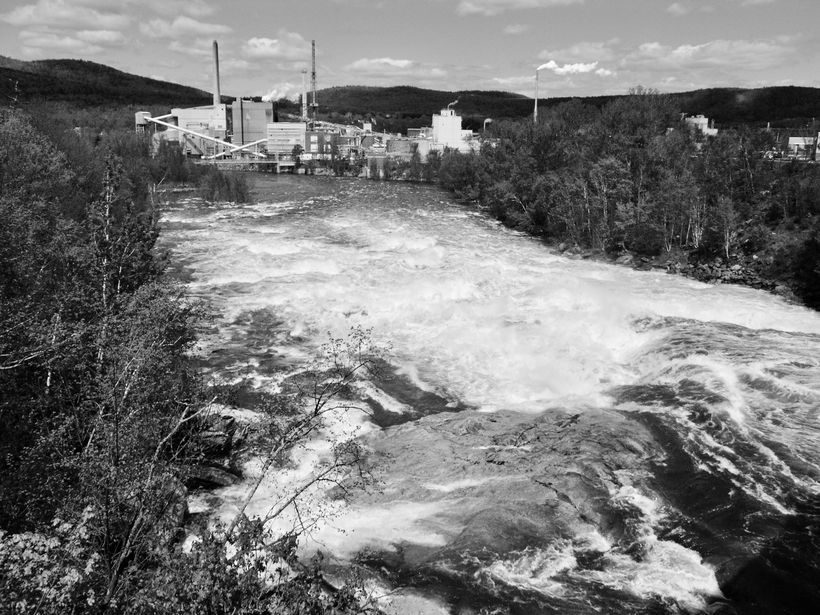The Androscoggin River flows 178 miles south from its source in Errol, New Hampshire, to the northern end of the White Mountains, then crosses the border into Maine. It winds east across the state, through the heart of Maine’s villages, towns, and cities, until it is subsumed, first by the Kennebec estuary and finally by the Atlantic Ocean. The Androscoggin has borne the boons and burdens of Maine’s people, from the native Abenaki who gave the river her name and harvested her fish, to the paper magnates who built an industry on her banks and polluted her waters.
Writer and editor Kerri Arsenault grew up on the Androscoggin River in the small town of Mexico, Maine. The river and its paper mills fed her family, their finances, and the town’s collective economy for over a hundred years until the chemical by-products of the paper manufacturing trade poisoned it all.
In her deeply researched and beautifully written book, Mill Town: Reckoning with What Remains, Arsenault returns to her hometown along the Androscoggin River armed with a zoom lens. She initially visits for her father’s funeral but comes back for extended research trips, looking at her history close up, “as if I am seeing the world from Alice’s point of view after she drank the potion that made her shrink.”
Through the Looking Glass
For most of Arsenault’s life, the river was her ever-fixed mark, a benign constant of the landscape. She took it for granted, never considering its impact on her health nor questioning the gifts it bestowed on her family. She was, she admits, too inured to see it clearly, like the myopic moose who travel along the back roads of Maine, “as nearsighted as I was to what had been happening in my hometown.” It wasn’t until Arsenault moved away that she was able to consider the impact of the Androscoggin and the paper industry on the people who depended on and labored in the mills of Maine.
Mill Town is a rich, rewarding read that defies easy categorization. Arsenault’s writing spans memoir and reference, narrative nonfiction and investigative journalism. Accordingly, her language meanders stylistically, flowing languorously from exposition to personal narrative and back again:
When the tide inhales the ocean, sediment slips back in the upriver return, building up the bay’s interstitial marshes until they become uplands, where humans build houses or bridges or industries or other monuments to themselves. When the tide exhales, sediment leaks into the ocean, carrying with it all those things we have tossed carelessly away, like debris from our activities or copper pennies flipped into water for luck. I read somewhere the practice began centuries ago when people would sacrifice coins to gods to ensure the continuation of clean water, something more valuable, apparently, than the coins surrendered.
The Androscoggin has borne the boons and burdens of Maine’s people, from the native Abenaki to the paper magnates.
As Arsenault dives deeper into her family history and the records detailing the lives and deaths of Mexico’s outsized cancer caseload, she learns the language of contaminants—persistent organic pollutants, half-lives, bioaccumulation, threshold limit values. Consider the lobster, Maine’s emblematic meal: while the state agencies that regulate and monitor Maine’s food and water sources won’t name “certain contaminants” that may be found in lobster meat, the Maine Center for Disease Control and Prevention advised its residents in 2008 to refrain from eating the lobster’s tomalley, or liver, out of concerns about toxic levels of exposure. What are (or are not) acceptable levels of chemical exposure for human ingestion, Arsenault discovers, “are based on politics” and “have nothing to do with health or biology.”
There’s a saying in politics—“As Maine goes, so goes the nation”—rooted in Maine’s longstanding reputation as a bellwether indicator for presidential elections, and Arsenault finds that Maine’s history of industrial contamination is an apt proxy for the state of the nation’s pollution management. As the health of Maine millworkers go, so goes the health of other Americans who work to provide the nation with the goods and services we depend on.
The deeper Arsenault dives into the research, the more she understands the difficulty of proving correlation, let alone causation, between pollution and disease. “Just when I start to connect the dots about cancer and pollution and family, more dots keep appearing like not-yet-discovered dark matter, which is only observable through its gravitational pull.” And then, just as all those evidentiary dots begin to line up for Arsenault, they scatter and disappear, erased by time and premature death, or hidden behind the obstinate will of those who would rather not know. In the end, she’s left with more questions than answers.
What we, the readers, are left with, however, is time well spent in a story well told. Despite the gravity of its subject, Mill Town is, at its heart, a love letter to the people and places of Arsenault’s childhood and a plea for a cleaner, brighter future.
Jessica Lahey is the author of The Gift of Failure and the upcoming The Addiction Inoculation

